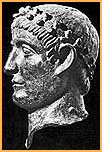|
The Early Byzantine period
The Byzantine Empire is in fact the Late Roman
Empire, c entered
on Constantinople, the New Rome. The term derives from Byzantium,
the ancient Greek colony chosen by
Constantine I
(307-337) to become his new imperial capital and renamed Constantinople.
The citizens of Constantinople were commonly refered to as
Byzantines, but they identified themselves, like the rest
of the empire's inhabitants, as Romans or simply as Christians.
The foundation of Constantinople in 324 and the conquest o0f
the same city by the Ottoman Turks in 1453 arbitrarily but
conveniently mark the rise and fall of the Byzantine Empire.
During these eleven centuries, Roman administrative tradition,
Christian religion, and Greek language formed the character
of the empire, while massive territorial loss profoundly altered
its physical aspect. entered
on Constantinople, the New Rome. The term derives from Byzantium,
the ancient Greek colony chosen by
Constantine I
(307-337) to become his new imperial capital and renamed Constantinople.
The citizens of Constantinople were commonly refered to as
Byzantines, but they identified themselves, like the rest
of the empire's inhabitants, as Romans or simply as Christians.
The foundation of Constantinople in 324 and the conquest o0f
the same city by the Ottoman Turks in 1453 arbitrarily but
conveniently mark the rise and fall of the Byzantine Empire.
During these eleven centuries, Roman administrative tradition,
Christian religion, and Greek language formed the character
of the empire, while massive territorial loss profoundly altered
its physical aspect.
Byzantine history can be divided into three periods,
the Early, the Middle and the Late. The Early Byzantine period
may be regarded as extending to about the middle of the seventh
century, which saw the rise of Islam and the definite installation
of the Arabs along the eastern and southern shores of the
Mediterranean; the Middle period, to the occupation of Asia
Minor by the Turks in the 1070s or to the capture of Constantinople
by the Crusaders in 1204; the Late period, from either one
of these dates to 1453.
The Early Byzantine empire (fourth to seventh centuries)
had largely the territory and administrative structures of
its Roman progenitor. However, the foundation of Constantinople
on the Bosphorus strait (modern Turkey), initiated an eastward
shift which facilitated the secession of western provinces.
By the sixth century, most of the western territories had
been invaded by barbarians. Rome itself was sacked twice (410
and 455), and was replaced by Ravenna as the capital of the
Ostrogothic kingdom. The tolerance of Christianity by decree
in 313, and its subsequent endorsement by most Roman emperors,
was of equal significance. Christianity spread around the
Meditteranean gaining in complexity and wealth, gradually
displacing pagan religion. The materials and vocabulary of
late Roman art and architecture were adapted to Christian
purposes. The fourth and fifth centuries saw the emergeance
of new forms, the maturity of which produced, in the sixth
century, a Byzantine art and architecture that acknowledged
but were largely independent of their Roman origins.
|